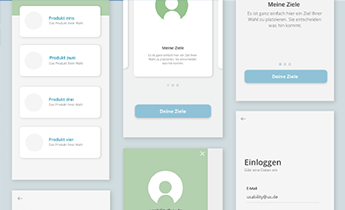Contextual Inquiries
Contextual Inquiries combine classical in-depth interviews with an observation of the users in the actual context of use. They are a suitable method to understand the users’ needs and requirements and to reveal environmental influences on the interaction with a product.

Our approach to Contextual Inquiries
The context in which a product is used often greatly influences the usability. Users in a warehouse might only have one free hand for the use of a mobile device, users in an industrial environment might be distracted by heat or noise while administrators have to save their actions when answering the phone. Contextual inquiries help us to collect the requirements of real users in a real context of use.
Our experts watch users, e.g. in their workplace or at home. They ask questions for a better understanding of the observed actions and record the user feedback and findings. This way, they identify context-dependent usability problems. They then develop recommendations on existing pain points and formulate requirements for a new design.
What can we find out with Contextual Inquiries?
- How do users use the product under real conditions, e.g. shortage of time or interruptions?
- Where and in which situations do problems occur?
- What do users use in addition to the product, e.g. notes, asking colleagues, search engine research, because information is missing and so on?
- How do external influences such as light, noise, or dirt influence the use?
- Which workarounds do users possibly use when missing a function?
- How do users work with the system when talking to other people at the same time (e.g. consultation or sales conversation)?
When do we recommend Contextual Inquiries?
Contextual inquiries are especially useful when the environment has a strong influence on the use and cannot readily be simulated in a lab. This applies to, e.g. industrial systems embedded in certain workflows.
The use of contextual inquiries is also beneficial in the context of requirements engineering. Influences deriving from the context can be recorded already while defining the requirements for the development or revision and thus be integrated in the design immediately.
Contextual inquiries also especially suitable for collecting information about target groups of a product and for obtaining a better understanding of their knowledge and experience. The collected data can be made tangible for the further development process, e.g. in the form of personas.
-
Inclusion of the environment of use
Characteristics such as ambient noise, lighting conditions, interruptions due to phone calls, or the parallel use of other systems are collected.
-
High accessibility of the target group
The experts visit the participants. This allows even the involvement of busy target groups.
-
Getting to know and understanding the target group
Information on previous knowledge, modes of operation, and user behavior can be collected.
-
Tests of stationary systems
Contextual inquiries are the ideal solution for products that cannot be easily transferred to a lab (e.g., an integrated display of an industrial robot).
A possible result: Personas
Focusing on your users: Personas
Personas are a possible result of contextual inquiries. They are fictitious users of a system’s target group, based on the data collected in the inquiry. They incorporate characteristics, values and practical behavioral patterns of a user group. The unspecific crowd of all users normally becomes tangible by defining 4-6 very detailed personas.
Concentrated in the form of a poster or file, the personas support the further development process. Instead of talking generally and subjectively about “our users”, personas can be actively involved in project meetings: “This function would be very helpful for Brigitt.” Personas ensure that all stake holders have the same target group in mind when it comes to decisions.

What are the results?
The result of a contextual inquiry depends on the project aim. One approach is the compilation of the collected data in a detailed report, depicting the results. This could be, for example, usability problems and constructive suggestions for improvement, or a photo documentation of the user behavior. Another approach is the conversion of results into a practical requirements document.
Do you have specific questions about the use of contextual inquiries in your project? We will be happy to advise you. Free of charge and at no obligation.





 Usability Testing
Usability Testing Eye Tracking
Eye Tracking Usability Review
Usability Review Prototyping
Prototyping